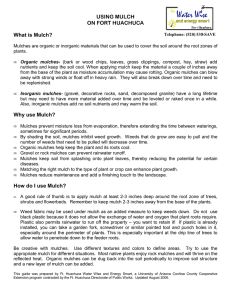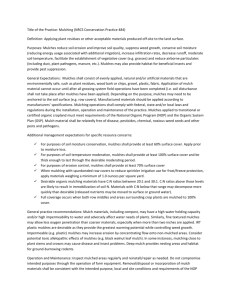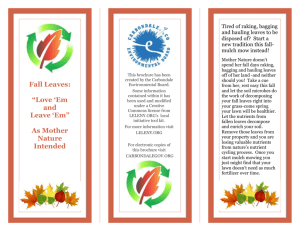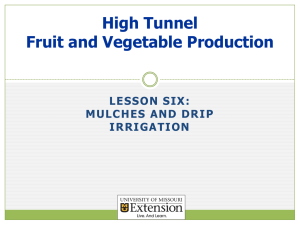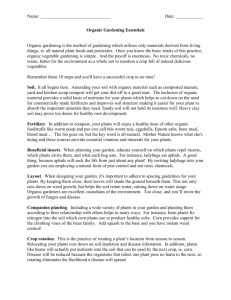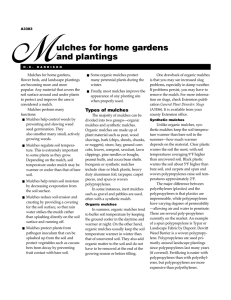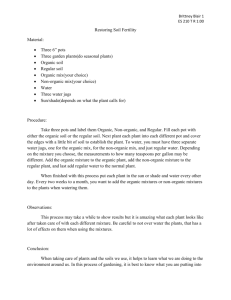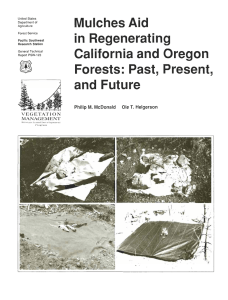Conservation-Practice-mulches-rewrite
advertisement
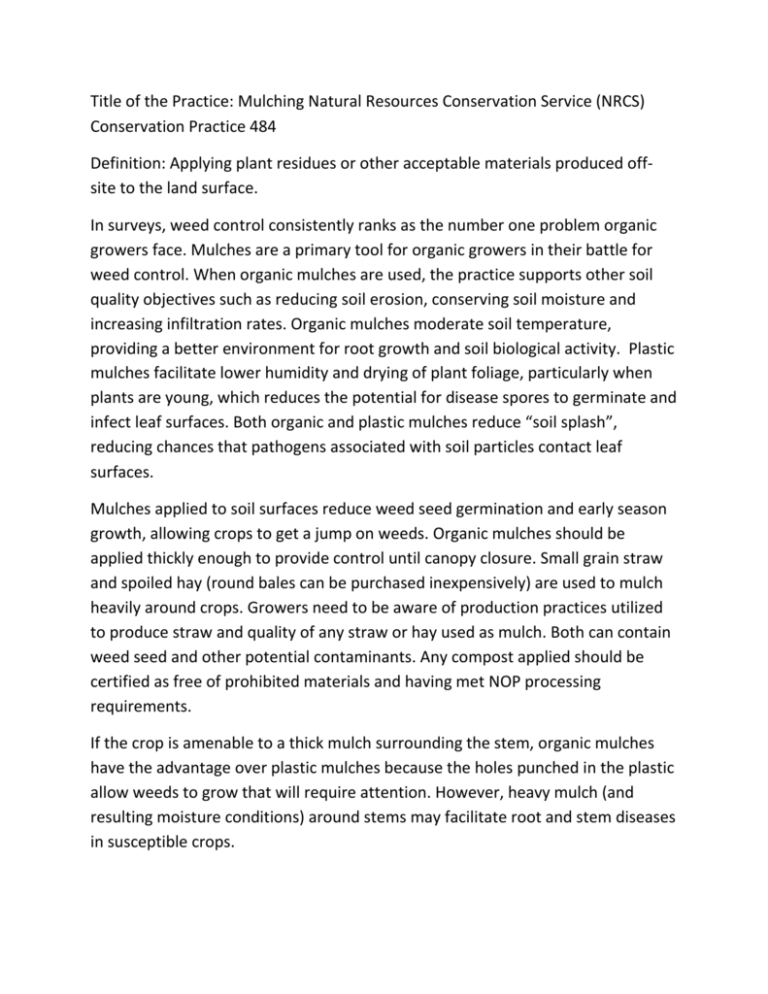
Title of the Practice: Mulching Natural Resources Conservation Service (NRCS) Conservation Practice 484 Definition: Applying plant residues or other acceptable materials produced offsite to the land surface. In surveys, weed control consistently ranks as the number one problem organic growers face. Mulches are a primary tool for organic growers in their battle for weed control. When organic mulches are used, the practice supports other soil quality objectives such as reducing soil erosion, conserving soil moisture and increasing infiltration rates. Organic mulches moderate soil temperature, providing a better environment for root growth and soil biological activity. Plastic mulches facilitate lower humidity and drying of plant foliage, particularly when plants are young, which reduces the potential for disease spores to germinate and infect leaf surfaces. Both organic and plastic mulches reduce “soil splash”, reducing chances that pathogens associated with soil particles contact leaf surfaces. Mulches applied to soil surfaces reduce weed seed germination and early season growth, allowing crops to get a jump on weeds. Organic mulches should be applied thickly enough to provide control until canopy closure. Small grain straw and spoiled hay (round bales can be purchased inexpensively) are used to mulch heavily around crops. Growers need to be aware of production practices utilized to produce straw and quality of any straw or hay used as mulch. Both can contain weed seed and other potential contaminants. Any compost applied should be certified as free of prohibited materials and having met NOP processing requirements. If the crop is amenable to a thick mulch surrounding the stem, organic mulches have the advantage over plastic mulches because the holes punched in the plastic allow weeds to grow that will require attention. However, heavy mulch (and resulting moisture conditions) around stems may facilitate root and stem diseases in susceptible crops. There are potential negative impacts to use of mulches. Impermeable (e.g. plastic) mulches may increase erosion by concentrating flow onto non-mulched areas. Consider potential toxic allelopathic effects of mulches (e.g. black walnut leaf mulch). In some instances, mulching close to plant stems and crowns may cause disease and insect problems. Deep mulch provides nesting areas and habitat for ground-burrowing rodents. Organic rules allow for the use of plastic mulches, though they must be removed at the end of the growing season. Use of plastic mulches remains controversial among organic growers, because of the non-renewable nature of the materials used in their manufacture and the fact that they cannot be reused (by NOP rules) in subsequent seasons. Some organic growers mediate the non-renewable nature of plastic mulches by purchasing “landscape fabric”, which can be used for as many as 8 to 10 years. At the end of the season these mulches are cleaned, rolled/folded up and stored. Growers “sanitize” the mulches with approved materials before reapplying them the following year. Landscape fabric has the additional benefit of being permeable to water infiltration. Organic and plastic mulches have different effects on root environment. Organic mulches applied to soils early in the season slow soil warming and drying and slow early season plant growth. When applied properly (close contact with soil facilitates conduction of heat from the plastic to the soil), black plastic mulches increase soil temperatures and early season growth. Infrared transmitting (IRT) mulches warms soil through transmission of radiation and conduction of heat. Later in the growing season, growers use white plastic mulch to reflect sunlight and moderate temperature at the soil surface. Clear plastic is not effective in controlling weeds, as they allow sunlight to stimulate weed growth underneath the mulch. Biodegradable plastic mulch is prohibited on organic farms. Spunbonded polyester mulches are used on organic farms for frost protection, and for insect control. According to the practice standard, when mulching with spunbonded row covers to reduce sprinkler irrigation use for frost/freeze protection, materials should minimally weigh 1.0 ounces per square yard. However, a lighter material is preferable for insect control, and material weighing 0.6 ounces per square yard allows greater light transmission and accommodates lower temperatures in the crop canopy. However, these materials need to be removed for pollinators. The practice standard defines desirable organic mulching materials as having C:N ratios between 20:1 and 30:1, because C:N ratios above those levels are likely to result in net immobilization of soil N. This contention might be contested by organic growers mulching with small grain straw, which has a C:N ratio of approximately 50:1. Materials with C:N ratios in this range will provide longer term weed control, as they decompose more slowly. There is certainly less of an issue with immobilization when materials are left on the surface rather than incorporated. Those producers who worry about immobilization should provide adequate N for both crop and microbial purposes. However, application of compost, whether surface applied or incorporated (not permitted by the practice), with C:N ratios over 30:1 are not advised in any case, as this C:N ratio would define a “low quality” compost. Removal/disposal or incorporation of mulch materials shall be consistent with the intended purpose, local and site conditions and requirements of the NOP and the OSP. Be vigilant that mulch materials do not catch fire. Evaluate results from mulching practices and adjust management as needed.
